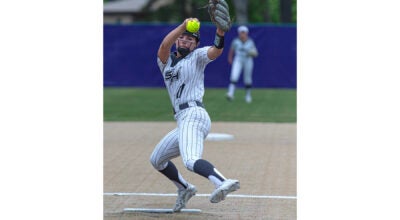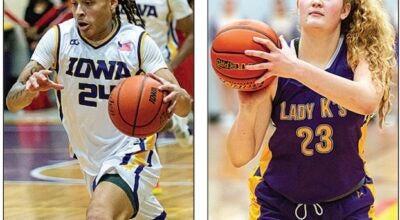Southwest Louisiana remembers glory days on gridiron
Published 12:30 pm Friday, August 30, 2013
To help show our support of exciting prep football action and the McNeese State University Cowboys, the American Press recruited a few fans, players and coaches to share their favorite memories.
Like many of us, Bill Krull, who was a sports writer at one time, can instantly recall the sensation of game night.
“I remember the tangible excitement in the air made vivid by the bright lights…the aromas of fresh-cut grass and just-popped corn heightened by the sounds of the bands and people talking in the stands.”
Kickoff your own journey down memory lane and prepare for the coming season as you read the following memories throughout the section and review area teams and their schedules for the 2013 season.
BECKY BROWN GROVE, DeQUINCY FAN-TASTIC
Becky Brown Grove has been faithfully going to DeQuincy High School games — both home and away — since the early 1970s.
“I don’t think I’ve missed but a couple. Once I missed because of surgery and another time I think it was because of a death.”
She went to the games before she had kids, when her kids were infants, after they were older and playing or were cheerleaders and now that those children are grown and have children of their own.
It’s the teamwork that motivates Grove to be such a die-hard fan.
“Football involves so many people, not just the players; and if they can work hard and show up, so can I.”
Grove may have inherited some of her staunch resolve to support the local team from her parents, Harvey and Betty Brown. Harvey played ball and was team captain. Betty cheered. They graduated from DeQuincy in 1946, and Harvey was part of the “chain gang,” never missing a game until his final days.
As for Grove’s high school years, she was the marching band majorette — a very loud one, she says.
Even the season when the Tigers went 0-10, she was there, yelling, waving and screaming encouraging words from the stands.
“They can hear me, because they tell me so,” Grove laughed.
“We can hear her and we’re not at the game,” some of her friends remarked.
She yells “for” the team and coaches. But she has been known to yell “at or against” the referees.
Her most memorable game was when the Tigers went to the Super Dome in 1995.
“Fred Gentry was playing,” she said. “When we got there, it was just overwhelmingly large. My son, Bryan, was a ball boy along with Tyler Richard and they looked so small in that setting, like ants.”
When asked about how she felt about all the detractors who shook their heads at DeQuincy’s chances, she said, “We didn’t care. We were there. I didn’t leave until it was over even though Haynesville beat DeQuincy 48-0.
“I never leave a game early,” Grove said.
She doesn’t just stay until the final buzzer. Up until recently she stayed to dish out the chicken that local restaurant owners Fausto and Toni Meija loaded up in her Suburban and provided for every away game — not only to the players but also to the fans, cheerleaders and boosters, as well.
Grove isn’t just a DeQuincy fan. She also roots for LSU and the New Orleans Saints.
She is married to Johnny Grove, with whom she attends Tiger football games.
“I hate the Dallas Cowboys,” she said.
And she doesn’t care who knows it.
WILRIDGE DOUCET, WESTLAKE
Wilridge Doucet, past mayor of Westlake and 1954 graduate of Westlake High School had no trouble remembering his gridiron days and was able to share the perspective of both player and coach. “Playing football set the stage for my life,” he said. “I would have never gone to college otherwise.” In the ‘40s, his family moved from Elton to Westlake. He became a junior policeman — a group of junior high kids who helped the elementary students cross the street safely. They also helped park cars for high school games. “Until then, I had never even seen a game.” That’s when Doucet decided to try out for football.
Training that begins in the blistering heat of Southwest La. summers is one of the first details that some players recall when recounting football memories. But in Doucet’s day, even though the training and games started a little later in the season, it was during an era that coaches didn’t let you drink water during practice. “The philosophy was, you couldn’t get in shape if you drank water. Looking back, I don’t know why it didn’t kill us.”
Doucet has the distinction of playing on the only Westlake High School State Championship Team. (They came close in 2007 but were defeated by Parkview Baptist for the 3A championship.) “I was a team co-captain, along with Mickey Benham. Bennie Ellender was coach. Benham went on to play ball at what was called the South Louisiana Institute then and is called ULL today. He coached at DeQuincy High School from ’71 – ’74.
Several colleges courted Doucet when he graduated but it was head McNeese coach A.I. Ratcliff who took the time to visit Doucet’s father, Paulus who had little opportunity for education. Ratcliff assured him that he would take care of his son if he allowed him to sign with the Cowboys. Doucet remembers his dad saying, “That’s where you need to go son.”
Playing for McNeese was “an eye opener” Doucet said. In ’54, veterans were coming back from Korea and playing college football. I was 19 playing with grown men.” Doucet was 5’8” and 180 lbs. and played guard. There were 45 on the squad who would substitute in and out on offense and defense. “Today there are probably 65 on a college team. Quarters were 15 minutes. We’d play about 14 minutes, come out and take a 2 minute break and go back in and play again.”
In the early 60s, coaches could withdraw scholarship money if they thought players weren’t performing to their satisfaction and between his freshman and sophomore year, McNeese changed coaches. The new coach was less interested in academics and Doucet soon scrapped his plans to be a chemist. He couldn’t miss a single practice and the lab and practice time conflicted.
Between Doucet’s sophomore and junior year this coach brought in junior college transfers. “He gave them all the scholarships and only three of the original team retained theirs, Senior Jesse Castete, Junior Glen Hathaway and Sophomore Doucet.”
This coach later went to work for the University of Georgia. According to Doucet, he was rumored to be involved in the1962 allegations of insider information between Alabama coach Paul “Bear” Bryant and former Georgia coach James Wallace “Wally” Butts.
Upon graduation from McNeese, Doucet served for 6 months in the army then began his coaching career at Westlake that spanned from 1959 to 1974. Marion and DeQuincy were Westlake’s greatest rivals during that time.
His perception of differences between coaching now and then includes: more rivalry between parents and larger players today. Another difference is, back in his day, coaches were full-time teachers — first — who coached part time.
Doucet served on the city council for eight years, was elected mayor and served for two terms beginning in 1974, served on the Calcasieu Parish School Board for 12 years and was an adjunct professor at McNeese and returned to coaching from 1982 – 1990 at W.W. Louis. He is also a retired Army Lt. Col.
An American Press subscriber since 1960, he still enjoys attending games and when he can’t see the game in person, he looks forward to reading about McNeese and Westlake football in the paper. He’s added Iowa and Sam Houston to his list of teams to follow. That’s where his grandchildren go to school. He is married to Helen Cooley Doucet, a native of Fields and their home is in Westlake.
JESSE CASTETE, MARION
Doucet’s McNeese teammate and Cowboy hall-of-famer, Jesse Castete, went on to play pro ball for the Chicago Bears and Cleveland Browns. He is described by the McNeese Cowboy website as “a standout running back and one of the first McNeese players to go on and play in the NFL. Doucet calls him “the most dedicated player I ever knew. He gave it everything.” Castete was named the Cowboys MVP, twice, was named to the all-Gulf States Conference team and accumulated 1,969 yards rushing.
When he began playing for McNeese he was 5’11” and 155 lbs. He got up to 188 at McNeese. He says it must have been the cafeteria food and the rope dangling from the ceiling in the gym. There was no year-round weight program like there is today. He may not be able to pull off the same time in the 100-yard-dash as he did back in the day – he is 80 now — but his wit is as quick as ever and one of the best stories he remembered was about a game against Trinity College. “They’re third team was as good as our first. They had a tiger in a cage that they would pull around the field behind a truck after each touch down. They ran out of gas that night after beating us 63 to nothing,” he laughed.
He was paid $6,000 for the year to play pro ball when he signed in the late 50s. (Today semiprofessionals make around $80,000. NFL stars can make in the millions.)
Castete coached for 25 years after his NFL days, starting at Vinton then going to Texas junior and community colleges. The three things he promised himself that he would never do again once he retired from coaching are ride a greyhound bus, eat fried chicken and stay until the end of a game.
His favorite all-time coach is Tom Landry and though he doesn’t have a particular team that he follows, he always roots against The Cowboys, “because of the way they fired Tom Landry,” he said.
About the recent “select/non-select” division of the LHSAA playoffs into public and non-public school brackets. Castete said, “I wasn’t really in favor of the change and thought the system we were using was good enough, but I guess we’re going to have to play it out and see how it goes.” (This new direction goes into effect this year and was adopted because of what seemed an unfair advantage of private schools to “select” players. Two such schools have claimed a combined 38 championships to date.)
MCNEESE EQUIPMENT MGR. FRED THOMAS
When Castete was asked about the focus on concussion education and treatment in high school sports, the conversation turned to advances in headgear.
Fred Thomas traveled first with the McNeese Cowboys as a fan in the 70s, then Coach Bobby Keesler asked him to drive the equipment to away games. Now he’s the equipment manager for the Cowboys. He had this to say about how helmets have changed: “When I played football, and that was the 40s in Ohio, you could fold your helmet and put it in your pocket. There was no facemask. Today, helmets are pumped up with air.”
Fabrics have changed too. “I still like cotton. You sweat, you get wet, you cool off and throw it in the washer and dryer and don’t worry about water temperature or dryer heat, he said. But players don’t play or practice in cotton any more. Today’s fabrics are different. They’re synthetics. They stretch and require particular detergents. “But we don’t have to worry about grass stains today. Artificial turf has taken care of that.”
When practices require full pads, McNeese Cowboy Managers launder up to seven loads a day in 40 lb. washers according to Thomas.
J.W. STINE, SULPHUR
Prominent Lake Area businessman, J.W. Stine attended Normal College, which is Northwestern State University today, on a football scholarship. He and J.C. Carlin were Sulphur High School teammates who built together what is now Stine Home and Yard Center. Their Sulphur football coach Dr. Hal Weathersby just recently passed away at the age of 98, but up until that time, the three kept in touch sharing, among other things, wonderful football memories.
Stine talks about football in his family history, which was shared by his grandson, Jeremy: “Many people told me I needed to get out of school and work. But I knew it was important for me to have the degree. I pushed it until I graduated. And I also loved playing football. I played quarterback for Sulphur High School for four years. Back then Vinton was our biggest rival. I remember the last year I played we beat them…”
JOEL HANKS, MOSS BLUFF
Joel Hanks, a 1999 graduate of Sam Houston High School and former high school player was a spectator at a Crowley/Moss Bluff game when the desire hit him to go out for the team. “It was cold. I remember the drums… the atmosphere. I wanted to be part of the tradition.” The tradition for Hanks turned out to be full of memories you would expect like grueling practices, parents who cheered him on, great performances of many team members including two running backs who passed the 1,000-yard mark and great coaching by Rhodes, Simon and Carl Flanagan. “I can still hear Coach Flanagan saying, ‘good lick’ when someone made a particularly hard tackle. But when he said it, sounded more like ‘good leeea.’ ”
Hanks would go into a game so hyped and nervous, he would throw up. Strangely enough, his upchucks became part of the team’s tradition. For details that may have escaped Hanks’ memory, his mother, who attended games both at home and away and recently passed away, left him a scrapbook of every clipping that had his name including one where he was named to the All District Second Team. “For an undersized offensive lineman, that wasn’t bad” he said.
However, he doesn’t need the scrapbook clippings to recall the death of 16-year-old teammate Gary Guidry during the season. “The whole team went to his funeral dressed in jerseys. His death hung over our class with a deep sadness that year.”
LANDON MITCHELL, DeQUINCY
This high school Tiger plays for “the love of the game.” Landon Mitchell, son of Billy and Laurie Mitchell said, “The rough practices and intense workouts make the games under those Friday night lights worthwhile. The first thing I thought about when I thought about football season starting at DHS this year was the scorching heat for the first practice. My second thought was, I’m a senior. So, I need to give every second of every game and practice my upmost best and give 110% on every play.”
JAMES DODD, OBERLIN
James Dodd, 1973 graduate and player, pointed out that most prep school athletes are too realistic to entertain fantasies of playing college and professional football. And since high school football is their last hurrah, they pour their hearts into it, creating a time in their lives not easily forgotten.
“When I think of high school football, I think of how much I miss it. High school is when it stops for so many of us. There are bad memories too, of the injuries. One teammate blew his knee out at the end of the season and wasn’t able to play anymore.
Hoyle Grangier knocked my younger brother out once. My brother was a small player and Hoyle — he was a big boy. When he ran, he could hurt you. I believe the Houston Oilers was the last team that Hoyle played with. I remember that practices were hot. Mr. Davis was the head coach. Today, football is a lot faster, more physical. Schools have weight rooms and coaching staffs concentrate on getting the players in shape. They play smarter.
CHEERLEADER LINDA DOUSAY REMEMBERS PAT HALEY
Linda Dousay was a cheerleader along with classmates Kenny Cagle and David Walker. “It was so long ago I can’t remember the names of all the cheerleaders,” she said. But one person she’ll never forget is Pat Haley, who still lives in Lake Charles. She made the cheer team’s first uniforms. “In fact, she made all of the uniforms until a few years ago when she became too weak to make them,” Dousay shared.
RIC FONTENTOT, McNEESE TAILGATE MAESTRO
If you want to know the ins and outs of tailgating, ask the man who’s been at it now for 40 years. Ric Fontenot, managing partner of Advantage Lumber Company, was tailgating when tailgating wasn’t even cool.
“I’ve been going to the games since the 70s. When I could finally afford season tickets in 1976 and wanted to start tailgating, the McNeese campus was a little restrictive. Alcohol wasn’t consumed in the public. A few people came early to the games but there wasn’t a lot of activity. No one brought tents.”
But Fontenot and his brothers, Southwest La. McNeese “foregaters” had an inkling of how to do it up right. They’d seen the fun tailgating could be when serious fans got together and socialized before pro or larger college games. “Historically, every college does it differently,” explained Fontenot.
So the Fontenot boys packed up the Weber grill, burger ‘fixins’ and set up where the students tailgate today. “We were a little worried when we started that we’d get in trouble.”
Today, serious tailgaters get to their pre-approved, rented areas Friday night to begin their ritual. McNeese colors wave and fans fuel up on food and spirits. They continue the socializing Saturday until game time and may even slip out at half time for refreshment. Bacon, eggs and Bloody Marys revive revelers Sunday morning for the journey home.
Fontenot is a member of the Petrochem Athletic Association. He and a couple of his friends customarily start their tailgating session by parking at multiple locations where liquid refreshment can be accessed at different times during the weekend. Their starting point is the Frosty Factory.
He says that by this time next year a new pavilion with restrooms, a full kitchen and a meeting area will be constructed for some of the McNeese tailgating groups and will also serve the needs of student activities during the week.
“As a tailgating colony we ‘meet’ on our website to plan the event. In a couple of weeks 400–500 people from Weber State in Ogden, Utah, are going to come down here and we’re going to feed them. They were impressed by our tailgating up there last year,” he said.
“There are people who don’t realize the great tailgating fun we have here and the whole atmosphere of camaraderie that surrounds the experience. But we have as good a tailgate tradition at McNeese as you’re going to find anywhere. As far as the Southland Conference goes, no one compares to us. The most exciting tailgating I’ve ever been involved in was during the first national championship game in Chattanooga. I remember when the McNeese band came marching up the street playing Jolie Blon.”
Tailgating spots are rented in advance. The “unofficial” sports website to get in touch with tailgaters like Fontenot, is Geuaxcowboys.com.
(Kirk Meche / Special to the American Press)





